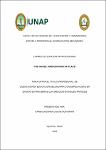| dc.contributor.author | Laiche Huaymana, Karen Jhoanna | |
| dc.date.accessioned | 2023-03-16T17:06:26Z | |
| dc.date.available | 2023-03-16T17:06:26Z | |
| dc.date.issued | 2018 | |
| dc.identifier.uri | https://hdl.handle.net/20.500.12737/8918 | |
| dc.description.abstract | This professional sufficiency exam that was supported through a learning session which is entitled "The House: Prepositions of place" and has as competencies: Understands everyday texts related to themselves, their family and their immediate environment. Produces different texts with cohesion and coherence, related to themselves and their family environment, using linguistic and non-linguistic elements. To achieve them, the following capacities have been considered: Predict the content of the text taking into account the paratextual elements. Identify the global or specific information of the text. Describe the information of a paratextual element using prepositions of place. Plan the production of the text, identifying the communicative situation. To measure achievement progress, the following indicators were formulated: Identifies the communicative situation by answering some questions and guessing the topic of the lesson. Identify vocabulary by looking at pictures and answering questions. Recognize the use of Prepositions of place describing an image. Produce a written text describing an image describing it with cohesion and coherence. The learning session has considered the didactic moments of beginning, process and exit. The theme of the session was contextualized with the parts of the house, objects that are in it, as well as the pet to motivate the learning of prepositions of place. For the evaluation, an observation sheet has been used with the proposed indicators, with a vigesimal evaluation scale from 0 to 20 and each indicator with a weight of 0-4. Metacognitive questions were also asked to reflect with the students on the process of learning during the session. Finally, at the end of the lesson the students managed to produce written texts of medium complexity describing the location of the objects that are in the house and they presented their products to the whole class for their improvement with the help of the teacher. | en_US |
| dc.description.abstract | Este examen de suficiencia profesional que fue sustentada a través de una sesión de aprendizaje la cual tiene como título “The House: Prepositions of place” y tiene como competencias: Comprende textos de uso cotidiano relacionados con ellos mismos, con su familia y su entorno inmediato. Produce diferentes textos con cohesión y coherencia, relacionados consigo mismos, con su entorno familiar, utilizando elementos lingüísticos y no lingüísticos. Para el logro de las mismas, se ha considerado las siguientes capacidades: Predice el contenido del texto teniendo en cuenta los elementos paratextuales. Identifica la información global o específica del texto. Describe la información de un elemento paratextual usando preposiciones de lugar. Planifica la producción del texto, identificando la situación comunicativa. Para medir los avances de logro se formularon los siguientes indicadores: Identifica la situación comunicativa respondiendo algunas preguntas y adivinando el tema de la lección. Identifica el vocabulario observando imágenes y respondiendo preguntas. Reconoce el uso de Preposiciones de lugar describiendo una imagen. Produce un texto escrito describiendo una imagen describiéndola con cohesión y coherencia. La sesión de aprendizaje ha considerado los momentos didácticos de inicio, proceso y salida. El tema de la sesión fue contextualizado con las partes de la casa, objetos que hay en ella así como la mascota para motivar el aprendizaje de las preposiciones de lugar. Para la evaluación se ha utilizado una ficha de observación con los indicadores propuestos, con una escala de evaluación vigesimal de 0 a 20 y cada indicador con un peso de 0 – 4. También se hicieron preguntas metacognitivas para reflexionar con los estudiantes sobre el proceso de aprendizaje durante la sesión. Finalmente, concluir que los estudiantes lograron producir textos escritos de mediana complejidad describiendo la ubicación de los objetos que hay en la casa y ellos presentaron sus productos a toda la clase para su mejora con ayuda de la docente. | es_PE |
| dc.format | application/pdf | es_PE |
| dc.language.iso | spa | es_PE |
| dc.publisher | Universidad Nacional de la Amazonía Peruana | es_PE |
| dc.rights | info:eu-repo/semantics/openAccess | * |
| dc.rights.uri | https://creativecommons.org/licenses/by/4.0/ | * |
| dc.subject | Demostración pedagógica | es_PE |
| dc.subject | Grámatica | es_PE |
| dc.subject | Método de enseñanza | es_PE |
| dc.subject | Inglés | es_PE |
| dc.title | The house: prepositions of place | es_PE |
| dc.type | info:eu-repo/semantics/bachelorThesis | es_PE |
| thesis.degree.discipline | Educación Secundaria con especialidad en Idiomas Extranjeros con mención en Inglés-Francés | es_PE |
| thesis.degree.grantor | Universidad Nacional de la Amazonía Peruana. Facultad de Ciencias de la Educación y Humanidades | es_PE |
| thesis.degree.name | Licenciado(a) en Educación Secundaria con especialidad en Idiomas Extranjeros con mención en Inglés-Francés | es_PE |
| dc.subject.ocde | https://purl.org/pe-repo/ocde/ford#5.03.01 | es_PE |
| renati.author.dni | 45617774 | |
| renati.type | https://purl.org/pe-repo/renati/type#trabajoDeSuficienciaProfesional | es_PE |
| renati.discipline | 121996 | es_PE |
| renati.level | https://purl.org/pe-repo/renati/level#tituloProfesional | es_PE |
| renati.juror | Vásquez Villalobos, Julia Victoria | |
| renati.juror | Nunes Noronha, Etsy Roxana | |
| renati.juror | Reátegui Torres, Gil Romer | |
| dc.publisher.country | PE | es_PE |





